Transform your outdoor space into a vibrant sanctuary with these 12 flower bed ideas, meticulously designed to suit every gardening style, climate, and skill level. From whimsical cottage gardens to sleek modern designs, each theme includes expert tips, plant-specific care guides, and design strategies to ensure your garden thrives. Let’s dig in!
1. Cottage Garden Charm
Romantic, informal beds bursting with color, fragrance, and nostalgia.
Design Tip: Layer plants in drifts—tall spires at the back, mounds in the middle, and spillers at the edges. Add vintage touches like a weathered bench or birdbath.

- Roses (e.g., David Austin English Roses)
- Sun: Full sun (6+ hours daily)
- Soil: Loamy, well-drained, pH 6.0–6.5
- Water: Deep watering once a week; avoid wetting foliage to prevent disease.
- Bloom: Repeat blooms from spring to fall.
- Care: Prune in early spring; feed with rose-specific fertilizer. Combat aphids with neem oil.
- Pro Tip: Pair with catmint or salvia to deter pests naturally.
- Lavender (e.g., Lavandula angustifolia)
- Sun: Full sun
- Soil: Sandy, alkaline (pH 6.7–7.3)
- Water: Drought-tolerant; water only during extreme dry spells.
- Bloom: Fragrant purple spikes in late spring to summer.
- Care: Prune back by 1/3 in early spring. Harvest stems before full bloom for drying.
- Foxgloves (Digitalis purpurea)
- Sun: Partial shade (morning sun, afternoon shade)
- Soil: Moist, humus-rich, well-drained
- Water: Keep soil consistently moist but not soggy.
- Bloom: Towering spikes in pink, white, or purple in early summer.
- Care: Biennial—let plants self-seed for future blooms. Toxic to pets.
Add More Cottage Classics:
- Delphiniums (full sun, staked stems)
- Hollyhocks (sun-loving, rustic charm)
- Sweet Peas (climbing, fragrant annuals).
2. Drought-Tolerant Succulent Bed
Water-wise beauty with sculptural shapes and textures.
Design Tip: Use terracotta pots or raised beds with gravel mulch for drainage. Group succulents by water needs.

- Sedum ‘Autumn Joy’
- Sun: Full sun to light shade
- Soil: Sandy, rocky, or poor soil
- Water: Once every 2–3 weeks; thrives on neglect.
- Bloom: Rosy pink clusters in late summer.
- Care: Divide clumps every 3 years. Attracts butterflies.
- Agave (e.g., Agave americana)
- Sun: Full sun
- Soil: Gritty, fast-draining mix
- Water: Sparingly (every 4–6 weeks).
- Bloom: Rare flower spikes (up to 20 years to bloom).
- Care: Wear gloves—sharp leaf tips!
- Russian Sage (Perovskia atriplicifolia)
- Sun: Full sun
- Soil: Tolerates poor, dry soil
- Water: Once monthly once established.
- Bloom: Airy lavender-blue plumes (summer to fall).
- Care: Cut back to 6″ in early spring. Deer-resistant.
Succulent Pairings:
- Echeveria (rosette-forming, ideal for containers)
- Aloe Vera (medicinal, sun-loving).
3. Perennial Paradise
Invest once, enjoy blooms year after year.
Design Tip: Use a mix of early, mid, and late-season bloomers for nonstop color.

- Peonies (Paeonia lactiflora)
- Sun: Full sun (6+ hours)
- Soil: Rich, well-drained, pH 6.5–7.5
- Water: Moderate; avoid overhead watering.
- Bloom: Large, fragrant blooms in late spring.
- Care: Ants on buds are normal—they help blooms open! Support with peony rings.
- Daylilies (Hemerocallis)
- Sun: Full sun to partial shade
- Soil: Adaptable; prefers slightly acidic
- Water: 1″ weekly; drought-tolerant once established.
- Bloom: Daily flowers in summer (each bloom lasts one day).
- Care: Deadhead spent blooms; divide every 3–5 years.
Extend the Season:
- Astilbe (shade-tolerant, feathery plumes)
- Black-Eyed Susan (sun-loving, late summer color).
4. Annual Color Explosion
Bold, fast-growing blooms for instant impact.
Design Tip: Use thrillers (tall), fillers (mid-height), and spillers (trailing) in containers or borders.
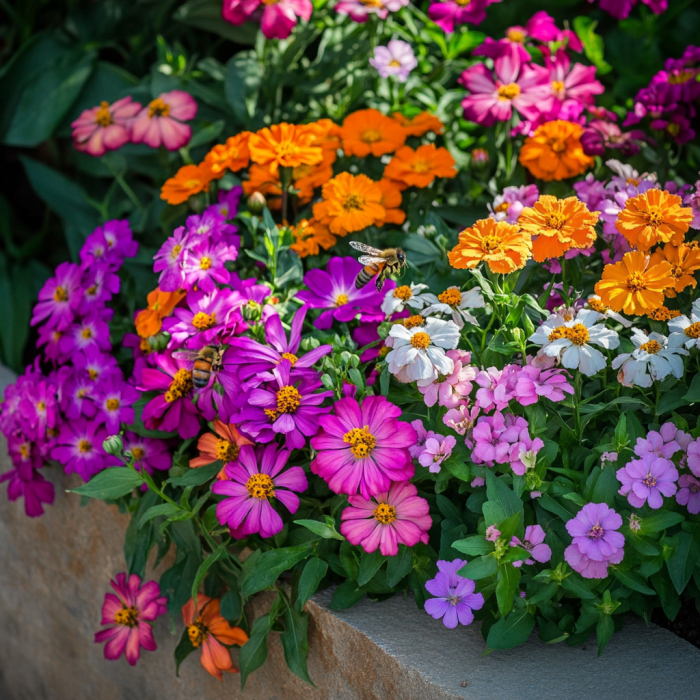
- Zinnias (Zinnia elegans)
- Sun: Full sun
- Soil: Average, well-drained
- Water: Moderate; avoid overhead watering to prevent mildew.
- Bloom: Vibrant daisy-like flowers from summer to frost.
- Care: Deadhead regularly; attracts butterflies.
- Marigolds (Tagetes)
- Sun: Full sun
- Soil: Tolerates poor soil
- Water: Let soil dry between waterings.
- Bloom: Orange, yellow, or red pom-poms.
- Care: Natural pest repellent (nematodes, aphids).
Mix & Match:
- Cosmos (airy, drought-tolerant)
- Impatiens (shade-loving, prolific blooms).
5. Shade-Loving Oasis
Lush foliage and subtle blooms for dim corners.
Design Tip: Brighten dark areas with white-flowered plants or variegated foliage.
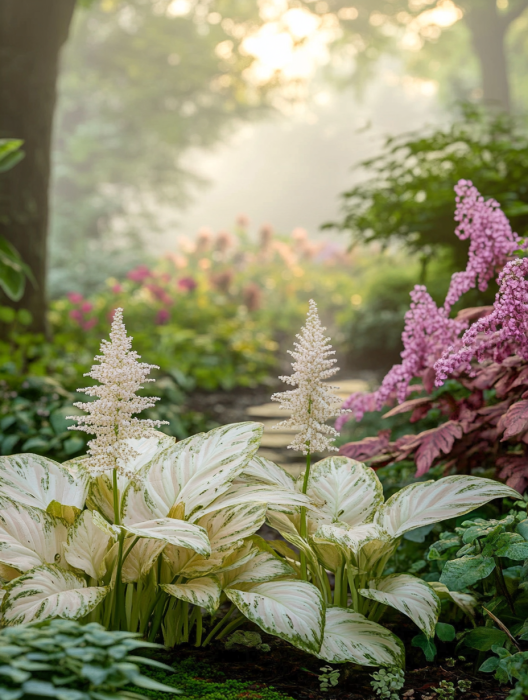
- Hostas
- Sun: Partial to full shade
- Soil: Moist, rich in organic matter
- Water: Keep soil consistently damp.
- Bloom: Pale lavender spikes in summer.
- Care: Slugs love hostas—use beer traps or copper tape.
- Astilbe
- Sun: Partial shade
- Soil: Moist, slightly acidic
- Water: Never let soil dry out.
- Bloom: Feathery plumes in pink, white, or red.
- Care: Divide every 4 years.
Shade Stars:
- Heuchera (coral bells—colorful foliage)
- Ferns (textural, low-light champions).
6. Rock Garden Retreat
Alpine plants and succulents for slopes or containers.
Design Tip: Mimic natural landscapes with sandstone boulders and creeping plants.
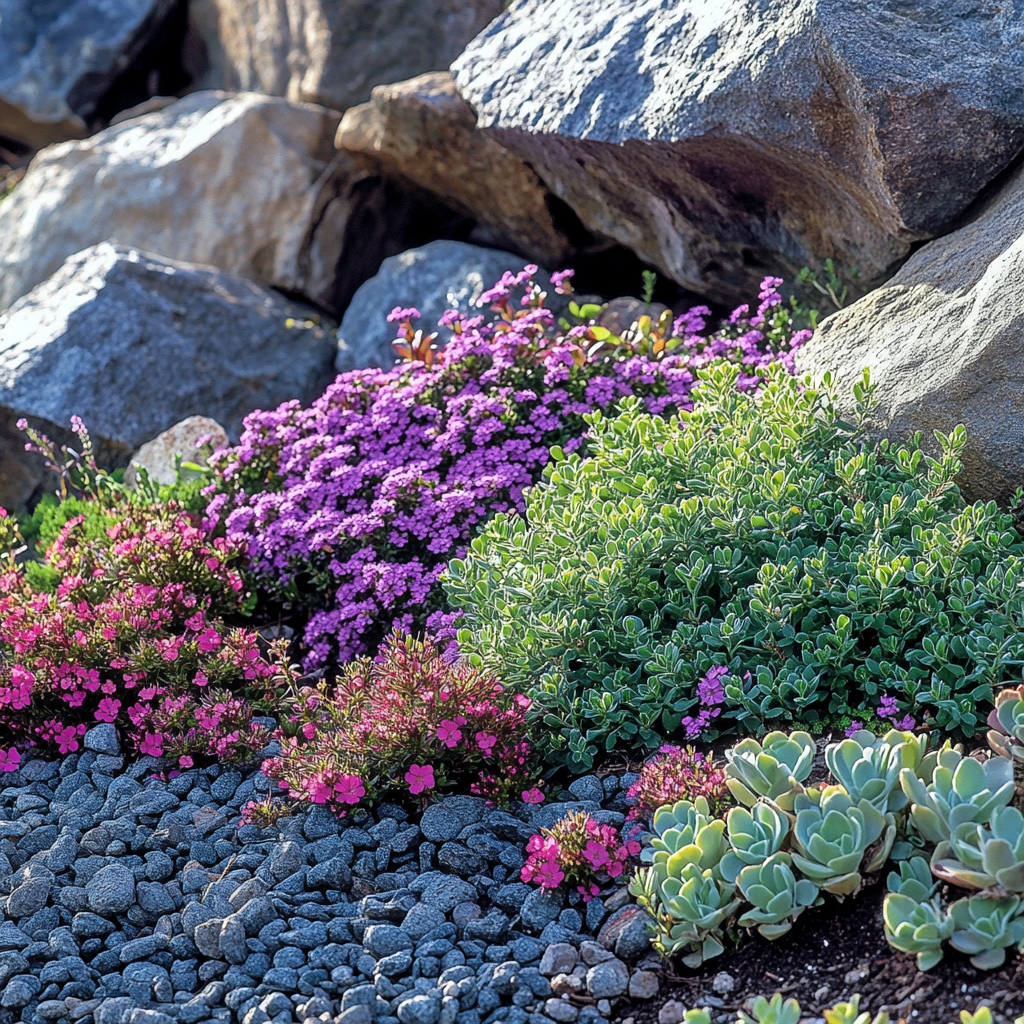
- Creeping Thyme
- Sun: Full sun
- Soil: Gritty, well-drained
- Water: Low; drought-tolerant.
- Bloom: Tiny purple flowers in summer.
- Care: Walkable groundcover; releases fragrance when crushed.
- Hens-and-Chicks (Sempervivum)
- Sun: Full sun
- Soil: Sandy, poor soil
- Water: Minimal; thrives in neglect.
- Bloom: Rosette-forming with occasional pink flowers.
- Care: Remove offsets to propagate.
Rock Garden Additions:
- Ice Plant (Delosperma—dazzling pink blooms)
- Blue Fescue Grass (ornamental, drought-tolerant).
7. Wildflower Meadow
A biodiverse, eco-friendly haven.
Design Tip: Combine native wildflowers and grasses. Mow once a year in late fall.

- Black-Eyed Susan (Rudbeckia hirta)
- Sun: Full sun
- Soil: Adaptable; prefers well-drained
- Water: Drought-tolerant once established.
- Bloom: Golden-yellow daisies summer to fall.
- Care: Self-seeds readily.
- California Poppy (Eschscholzia californica)
- Sun: Full sun
- Soil: Poor, sandy
- Water: Minimal
- Bloom: Bright orange cups in spring.
- Care: State flower of California; thrives in neglect.
Native Mixes:
- Lupine (nitrogen-fixing, spiky blooms)
- Milkweed (monarch butterfly host).
8. Edible Flower Garden
Beauty you can eat!
Design Tip: Plant near kitchens for easy harvesting. Avoid pesticides.
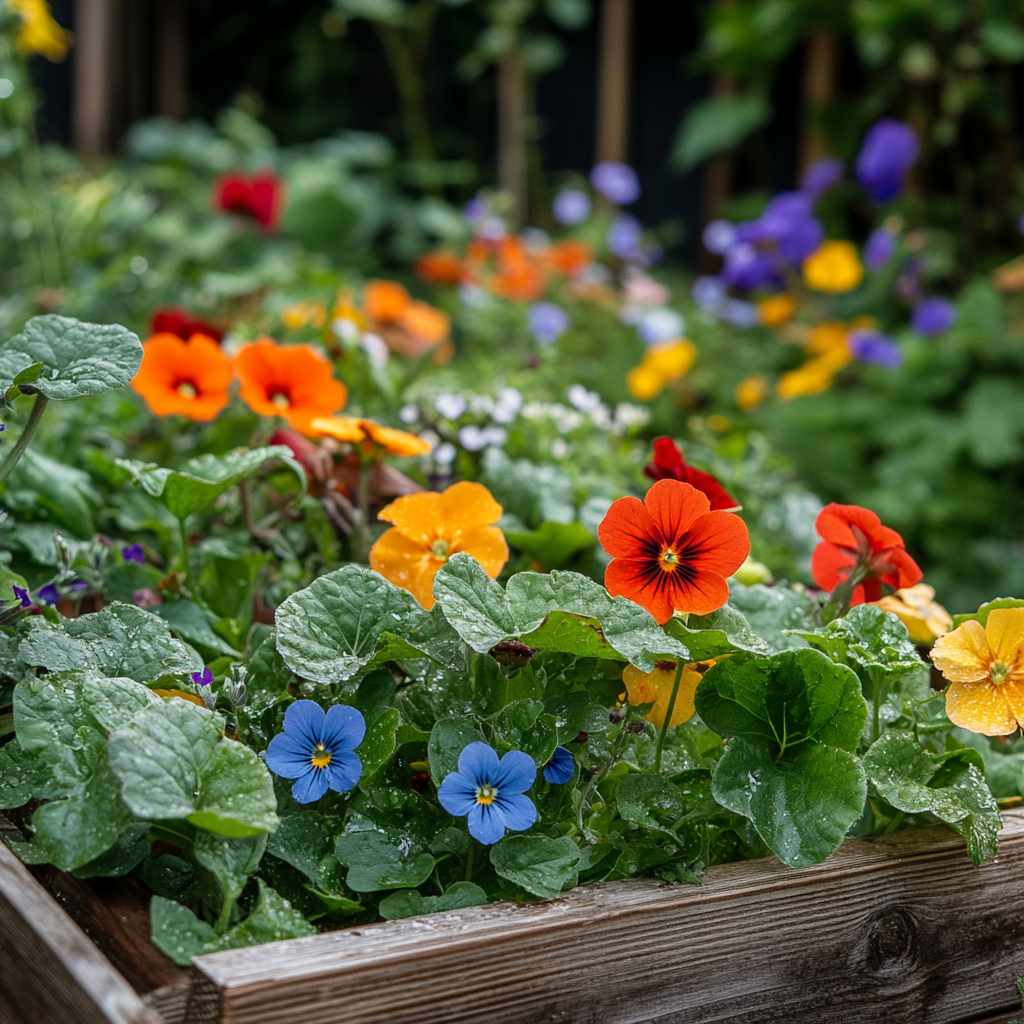
- Nasturtiums
- Sun: Full sun to partial shade
- Soil: Poor, well-drained (rich soil reduces blooms).
- Water: Moderate
- Bloom: Peppery edible flowers in red, orange, yellow.
- Care: Trailing varieties work in hanging baskets.
- Calendula
- Sun: Full sun
- Soil: Average
- Water: Moderate
- Bloom: Bright orange/yellow petals (great for salves).
- Care: Deadhead to prolong blooms.
Tasty Additions:
- Borage (blue star-shaped flowers, cucumber flavor)
- Violas (candied or salad-toppers).
9. Monochromatic Elegance
Single-color themes for drama and cohesion.
Design Tip: Add texture with variegated foliage or silver accents (e.g., lamb’s ear).
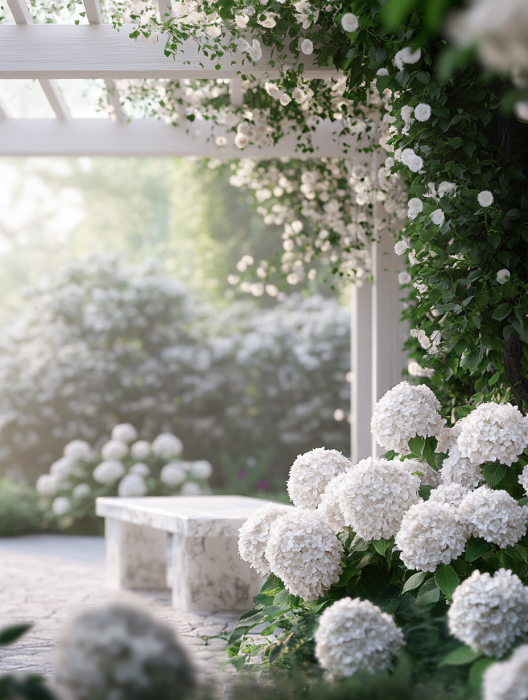
- White Hydrangeas (Hydrangea arborescens)
- Sun: Morning sun, afternoon shade
- Soil: Moist, rich, slightly acidic
- Water: Keep soil consistently damp.
- Bloom: Large snowball clusters summer to fall.
- Care: Prune in late winter.
- Purple Alliums
- Sun: Full sun
- Soil: Well-drained
- Water: Moderate
- Bloom: Globe-shaped flowers in late spring.
- Care: Plant bulbs in fall; deer-resistant.
Monochromatic Pairings:
- Silver Dust (Dusty Miller)
- White Cosmos (airy contrast).
10. Vertical Flower Bed
Ideal for small spaces or urban gardens.
Design Tip: Use obelisks, trellises, or wall-mounted planters.
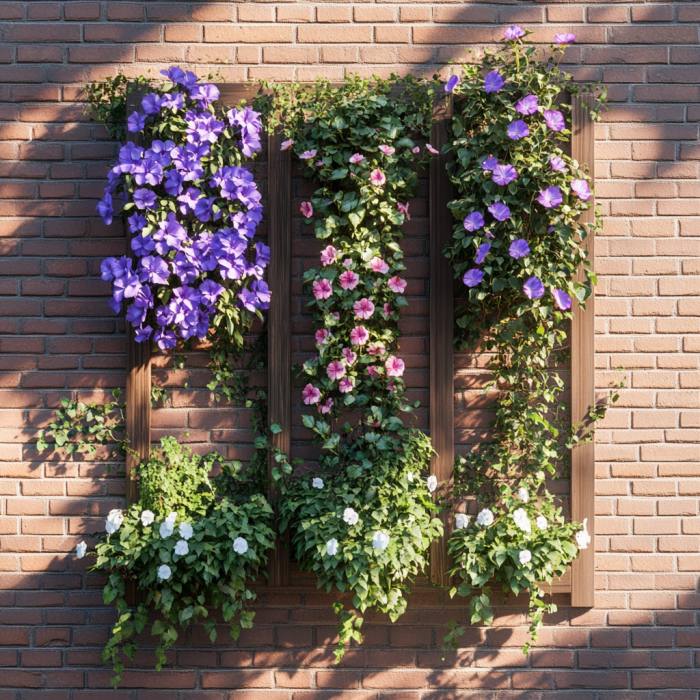
- Clematis
- Sun: Full sun (keep roots shaded with mulch or stones).
- Soil: Moist, well-drained, neutral pH
- Water: Regularly, especially during blooming.
- Bloom: Large flowers in purple, pink, or white (varies by species).
- Care: Pruning group depends on variety—research before cutting!
- Morning Glory (Ipomoea)
- Sun: Full sun
- Soil: Average
- Water: Moderate
- Bloom: Trumpet-shaped blooms in blue, purple, or pink.
- Care: Annual; self-seeds aggressively.
Vertical Stars:
- Climbing Roses (train on arches)
- Sweet Peas (fragrant, cool-season annuals).
11. Butterfly and Bee Haven
Nectar-rich blooms to support pollinators.
Design Tip: Avoid pesticides; plant in clusters for easy foraging.
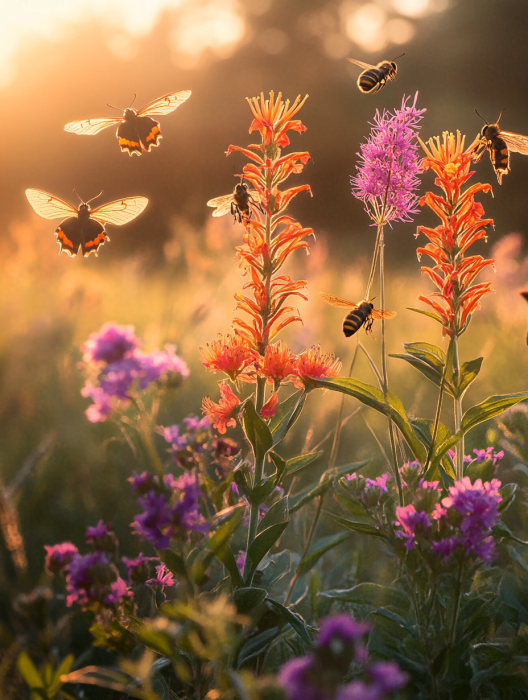
- Milkweed (Asclepias)
- Sun: Full sun
- Soil: Sandy, well-drained
- Water: Low
- Bloom: Pink, orange, or yellow clusters in summer.
- Care: Host plant for monarch caterpillars.
- Bee Balm (Monarda)
- Sun: Full sun to partial shade
- Soil: Moist, fertile
- Water: Regular
- Bloom: Shaggy red, pink, or purple flowers.
- Care: Prone to powdery mildew—space plants for airflow.
Pollinator Favorites:
- Liatris (blazing star—purple spikes)
- Phlox (fragrant, long-blooming).
12. Seasonal Rotation Bed
Refresh your garden with the seasons.
Design Tip: Plan a calendar: spring bulbs → summer annuals → fall mums → winter evergreens.
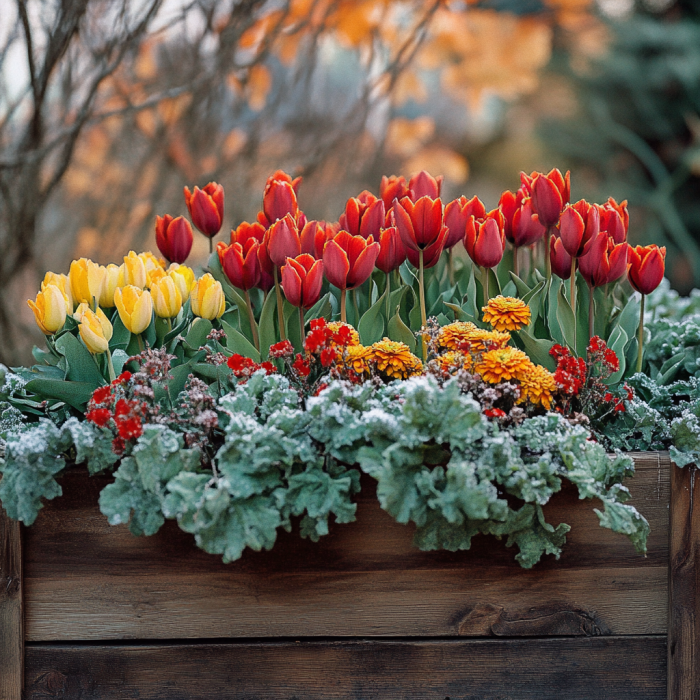
- Tulips (Spring)
- Sun: Full sun
- Soil: Well-drained
- Water: Moderate in spring.
- Bloom: April–May (varies by zone).
- Care: Plant bulbs 8″ deep in fall; deter squirrels with chicken wire.
- Chrysanthemums (Fall)
- Sun: Full sun
- Soil: Fertile, well-drained
- Water: Keep moist
- Bloom: September–October
- Care: Pinch back stems in summer for bushier growth.
Year-Round Rotation:
- Pansies (cool-season color)
- Ornamental Kale (winter interest).
Conclusion
Your garden is a canvas—mix and match these ideas to reflect your personality and local climate. Whether you’re crafting a serene shade retreat or a buzzing pollinator paradise, thoughtful design and plant care will ensure a stunning, sustainable space.
FAQ
- Q: How do I improve soil for flower beds?
A: Add compost annually and test soil pH. - Q: What flowers grow well in clay soil?
A: Daylilies, coneflowers, and asters tolerate heavy soil.
Ready to get your hands dirty? Share your favorite flower bed ideas in the comments below! 🌸🌿